Entrepreneurial Strategy for Next: PESTEL, SWOT, and Market Analysis
VerifiedAdded on 2023/01/11
|11
|2684
|90
Report
AI Summary
This report provides a comprehensive analysis of Next, a major UK retailer, focusing on its entrepreneurial strategy. It begins with an introduction to entrepreneurial strategy and its importance, followed by a detailed examination of Next's business operations. The core of the report comprises a PESTEL analysis, evaluating the political, economic, social, technological, environmental, and legal factors impacting Next. A SWOT analysis is then presented, highlighting Next's strengths, weaknesses, opportunities, and threats. The report identifies potential challenges Next faces in maintaining its market position, particularly related to product development and market expansion. The ANSOFF matrix is suggested as a tool for strategic planning, enabling product development and market penetration. The report concludes by summarizing the key findings and emphasizing the importance of strategic adaptation for sustained success in the competitive retail environment.
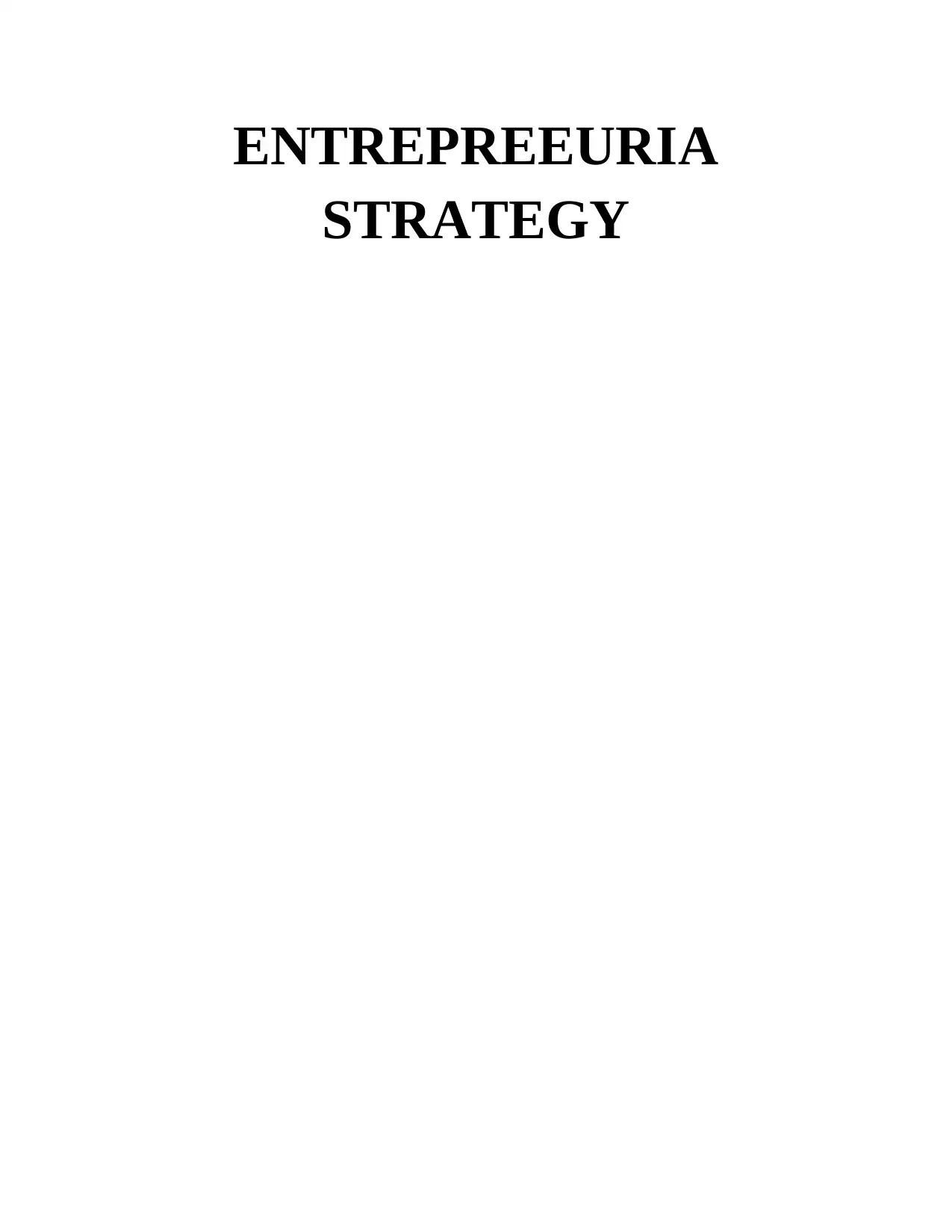
ENTREPREEURIA
STRATEGY
STRATEGY
Paraphrase This Document
Need a fresh take? Get an instant paraphrase of this document with our AI Paraphraser
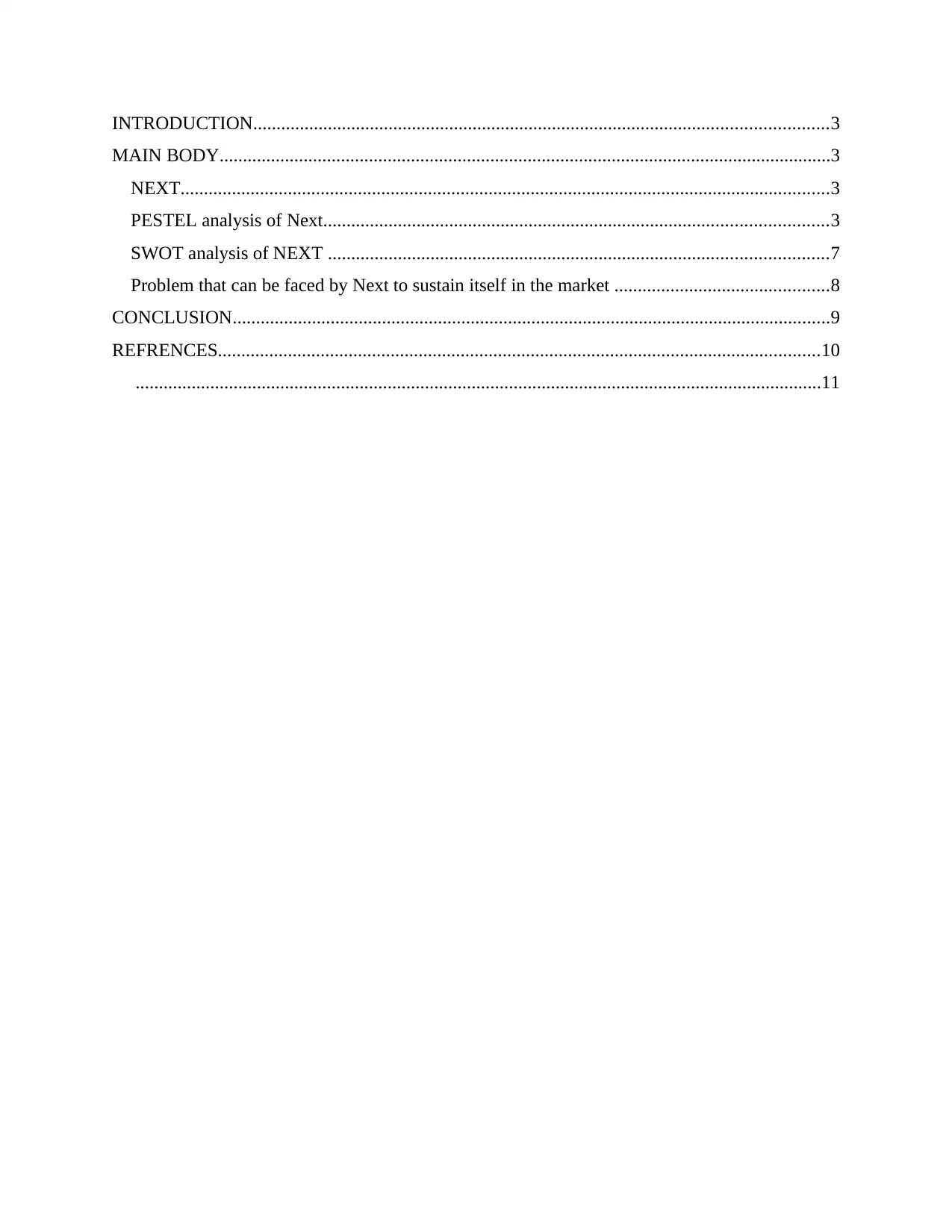
INTRODUCTION...........................................................................................................................3
MAIN BODY...................................................................................................................................3
NEXT...........................................................................................................................................3
PESTEL analysis of Next............................................................................................................3
SWOT analysis of NEXT ...........................................................................................................7
Problem that can be faced by Next to sustain itself in the market ..............................................8
CONCLUSION................................................................................................................................9
REFRENCES.................................................................................................................................10
...................................................................................................................................................11
MAIN BODY...................................................................................................................................3
NEXT...........................................................................................................................................3
PESTEL analysis of Next............................................................................................................3
SWOT analysis of NEXT ...........................................................................................................7
Problem that can be faced by Next to sustain itself in the market ..............................................8
CONCLUSION................................................................................................................................9
REFRENCES.................................................................................................................................10
...................................................................................................................................................11

INTRODUCTION
Entrepreneurial strategy is that kind of strategy through which an organization establishes
and re-establishes its fundamental set of relationships with it environment. In other words these
are those strategies that are responsible for establishing of decision making process within an
organization and affecting the process involved in it. These strategies are related to various
aspects of business. Scope of this strategy is wider because it covers those things that is
important for an organization to grow itself. The following file is going to be based over Next
that is larger retailer in UK and has variety of products to sell. In these file things that is going to
cover is based upon PESTEL analysis, SWOT analysis and ANSOF matrix. Further in this file
problem that can be faced by an organization is going to be explained. Also appropriate solutions
going to be provided for problem face by an organization.
MAIN BODY
NEXT
Next is an British multinational clothing, footwear and home products retailer. It has its
headquarter in Ender by, Leicestershire. It has around 700 stores which circa 500 are in United
Kingdom and rest 200 is across Europe, Asia and Middle East. Next being a popular retailer it
has various wide ranges of products that are of various types. Next consists of two types of
factors within an organization. These factors can have very adverse affect over an organization
because of their tendency to affect overall working procedure of an organization. These factors
are responsible for growth of company. External factors are those type of factors that is
responsible for creating an impact upon a company through external forces. External factors are
those factors which affect an organization from inside. In order to mark these factors two
analysis are done that is SWOT and PESTEL.
PESTEL analysis of Next
PESTLE analysis is that kind of tool which deals with factors related to macro
environment within an organization. Factors included in this analysis are political, economic,
social, technological, environmental and legal which affects formation of strategies in an
Entrepreneurial strategy is that kind of strategy through which an organization establishes
and re-establishes its fundamental set of relationships with it environment. In other words these
are those strategies that are responsible for establishing of decision making process within an
organization and affecting the process involved in it. These strategies are related to various
aspects of business. Scope of this strategy is wider because it covers those things that is
important for an organization to grow itself. The following file is going to be based over Next
that is larger retailer in UK and has variety of products to sell. In these file things that is going to
cover is based upon PESTEL analysis, SWOT analysis and ANSOF matrix. Further in this file
problem that can be faced by an organization is going to be explained. Also appropriate solutions
going to be provided for problem face by an organization.
MAIN BODY
NEXT
Next is an British multinational clothing, footwear and home products retailer. It has its
headquarter in Ender by, Leicestershire. It has around 700 stores which circa 500 are in United
Kingdom and rest 200 is across Europe, Asia and Middle East. Next being a popular retailer it
has various wide ranges of products that are of various types. Next consists of two types of
factors within an organization. These factors can have very adverse affect over an organization
because of their tendency to affect overall working procedure of an organization. These factors
are responsible for growth of company. External factors are those type of factors that is
responsible for creating an impact upon a company through external forces. External factors are
those factors which affect an organization from inside. In order to mark these factors two
analysis are done that is SWOT and PESTEL.
PESTEL analysis of Next
PESTLE analysis is that kind of tool which deals with factors related to macro
environment within an organization. Factors included in this analysis are political, economic,
social, technological, environmental and legal which affects formation of strategies in an
⊘ This is a preview!⊘
Do you want full access?
Subscribe today to unlock all pages.

Trusted by 1+ million students worldwide
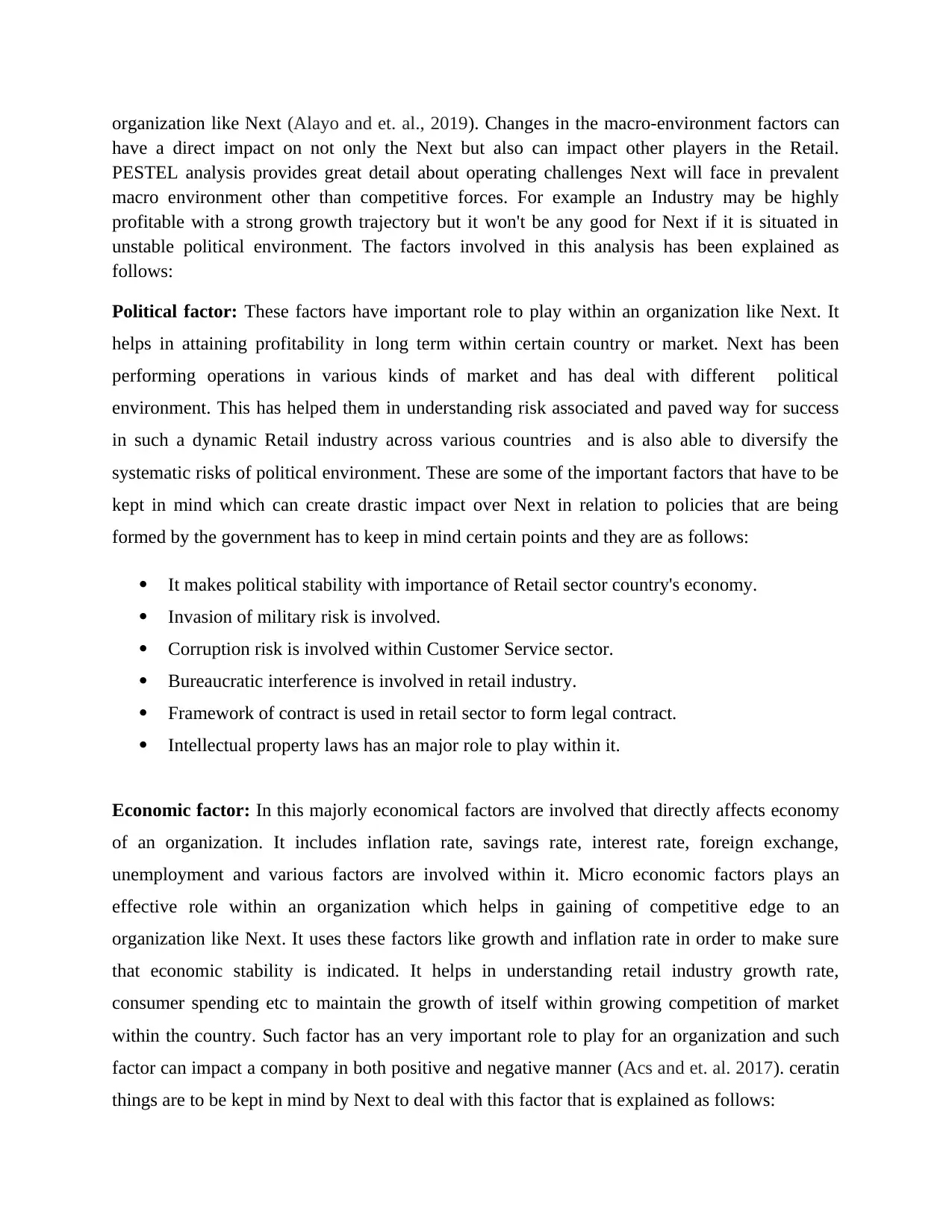
organization like Next (Alayo and et. al., 2019). Changes in the macro-environment factors can
have a direct impact on not only the Next but also can impact other players in the Retail.
PESTEL analysis provides great detail about operating challenges Next will face in prevalent
macro environment other than competitive forces. For example an Industry may be highly
profitable with a strong growth trajectory but it won't be any good for Next if it is situated in
unstable political environment. The factors involved in this analysis has been explained as
follows:
Political factor: These factors have important role to play within an organization like Next. It
helps in attaining profitability in long term within certain country or market. Next has been
performing operations in various kinds of market and has deal with different political
environment. This has helped them in understanding risk associated and paved way for success
in such a dynamic Retail industry across various countries and is also able to diversify the
systematic risks of political environment. These are some of the important factors that have to be
kept in mind which can create drastic impact over Next in relation to policies that are being
formed by the government has to keep in mind certain points and they are as follows:
It makes political stability with importance of Retail sector country's economy.
Invasion of military risk is involved.
Corruption risk is involved within Customer Service sector.
Bureaucratic interference is involved in retail industry.
Framework of contract is used in retail sector to form legal contract.
Intellectual property laws has an major role to play within it.
Economic factor: In this majorly economical factors are involved that directly affects economy
of an organization. It includes inflation rate, savings rate, interest rate, foreign exchange,
unemployment and various factors are involved within it. Micro economic factors plays an
effective role within an organization which helps in gaining of competitive edge to an
organization like Next. It uses these factors like growth and inflation rate in order to make sure
that economic stability is indicated. It helps in understanding retail industry growth rate,
consumer spending etc to maintain the growth of itself within growing competition of market
within the country. Such factor has an very important role to play for an organization and such
factor can impact a company in both positive and negative manner (Acs and et. al. 2017). ceratin
things are to be kept in mind by Next to deal with this factor that is explained as follows:
have a direct impact on not only the Next but also can impact other players in the Retail.
PESTEL analysis provides great detail about operating challenges Next will face in prevalent
macro environment other than competitive forces. For example an Industry may be highly
profitable with a strong growth trajectory but it won't be any good for Next if it is situated in
unstable political environment. The factors involved in this analysis has been explained as
follows:
Political factor: These factors have important role to play within an organization like Next. It
helps in attaining profitability in long term within certain country or market. Next has been
performing operations in various kinds of market and has deal with different political
environment. This has helped them in understanding risk associated and paved way for success
in such a dynamic Retail industry across various countries and is also able to diversify the
systematic risks of political environment. These are some of the important factors that have to be
kept in mind which can create drastic impact over Next in relation to policies that are being
formed by the government has to keep in mind certain points and they are as follows:
It makes political stability with importance of Retail sector country's economy.
Invasion of military risk is involved.
Corruption risk is involved within Customer Service sector.
Bureaucratic interference is involved in retail industry.
Framework of contract is used in retail sector to form legal contract.
Intellectual property laws has an major role to play within it.
Economic factor: In this majorly economical factors are involved that directly affects economy
of an organization. It includes inflation rate, savings rate, interest rate, foreign exchange,
unemployment and various factors are involved within it. Micro economic factors plays an
effective role within an organization which helps in gaining of competitive edge to an
organization like Next. It uses these factors like growth and inflation rate in order to make sure
that economic stability is indicated. It helps in understanding retail industry growth rate,
consumer spending etc to maintain the growth of itself within growing competition of market
within the country. Such factor has an very important role to play for an organization and such
factor can impact a company in both positive and negative manner (Acs and et. al. 2017). ceratin
things are to be kept in mind by Next to deal with this factor that is explained as follows:
Paraphrase This Document
Need a fresh take? Get an instant paraphrase of this document with our AI Paraphraser
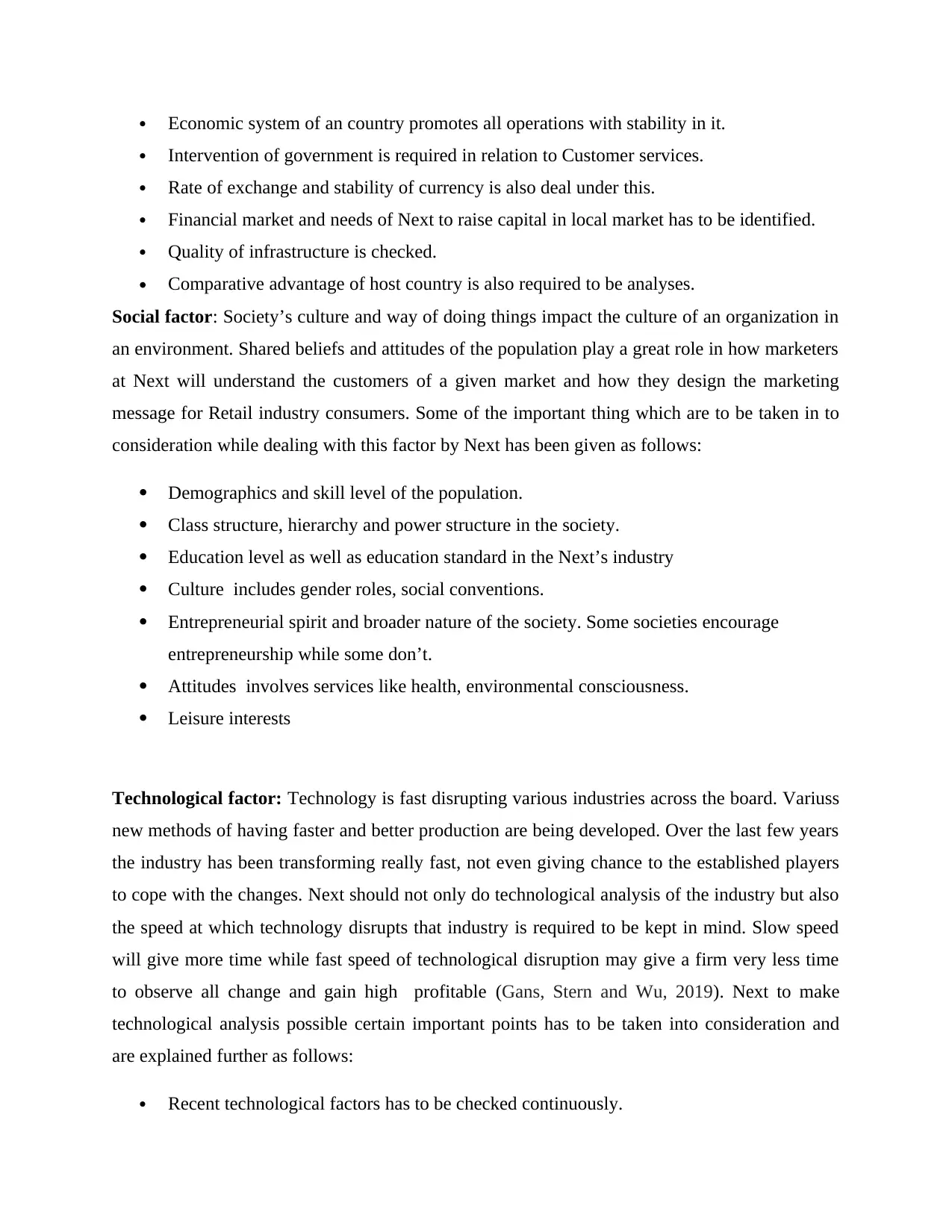
Economic system of an country promotes all operations with stability in it.
Intervention of government is required in relation to Customer services.
Rate of exchange and stability of currency is also deal under this.
Financial market and needs of Next to raise capital in local market has to be identified.
Quality of infrastructure is checked.
Comparative advantage of host country is also required to be analyses.
Social factor: Society’s culture and way of doing things impact the culture of an organization in
an environment. Shared beliefs and attitudes of the population play a great role in how marketers
at Next will understand the customers of a given market and how they design the marketing
message for Retail industry consumers. Some of the important thing which are to be taken in to
consideration while dealing with this factor by Next has been given as follows:
Demographics and skill level of the population.
Class structure, hierarchy and power structure in the society.
Education level as well as education standard in the Next’s industry
Culture includes gender roles, social conventions.
Entrepreneurial spirit and broader nature of the society. Some societies encourage
entrepreneurship while some don’t.
Attitudes involves services like health, environmental consciousness.
Leisure interests
Technological factor: Technology is fast disrupting various industries across the board. Variuss
new methods of having faster and better production are being developed. Over the last few years
the industry has been transforming really fast, not even giving chance to the established players
to cope with the changes. Next should not only do technological analysis of the industry but also
the speed at which technology disrupts that industry is required to be kept in mind. Slow speed
will give more time while fast speed of technological disruption may give a firm very less time
to observe all change and gain high profitable (Gans, Stern and Wu, 2019). Next to make
technological analysis possible certain important points has to be taken into consideration and
are explained further as follows:
Recent technological factors has to be checked continuously.
Intervention of government is required in relation to Customer services.
Rate of exchange and stability of currency is also deal under this.
Financial market and needs of Next to raise capital in local market has to be identified.
Quality of infrastructure is checked.
Comparative advantage of host country is also required to be analyses.
Social factor: Society’s culture and way of doing things impact the culture of an organization in
an environment. Shared beliefs and attitudes of the population play a great role in how marketers
at Next will understand the customers of a given market and how they design the marketing
message for Retail industry consumers. Some of the important thing which are to be taken in to
consideration while dealing with this factor by Next has been given as follows:
Demographics and skill level of the population.
Class structure, hierarchy and power structure in the society.
Education level as well as education standard in the Next’s industry
Culture includes gender roles, social conventions.
Entrepreneurial spirit and broader nature of the society. Some societies encourage
entrepreneurship while some don’t.
Attitudes involves services like health, environmental consciousness.
Leisure interests
Technological factor: Technology is fast disrupting various industries across the board. Variuss
new methods of having faster and better production are being developed. Over the last few years
the industry has been transforming really fast, not even giving chance to the established players
to cope with the changes. Next should not only do technological analysis of the industry but also
the speed at which technology disrupts that industry is required to be kept in mind. Slow speed
will give more time while fast speed of technological disruption may give a firm very less time
to observe all change and gain high profitable (Gans, Stern and Wu, 2019). Next to make
technological analysis possible certain important points has to be taken into consideration and
are explained further as follows:
Recent technological factors has to be checked continuously.
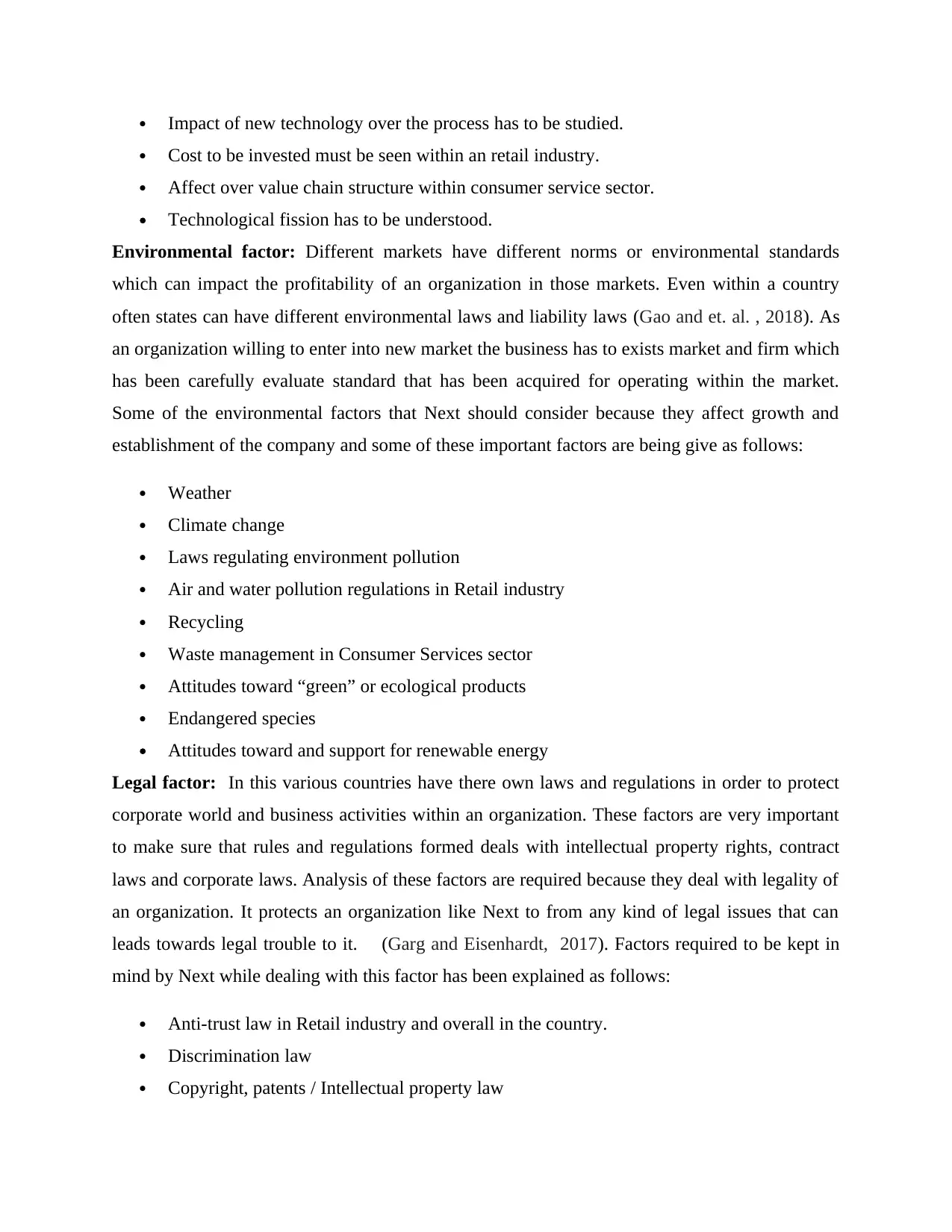
Impact of new technology over the process has to be studied.
Cost to be invested must be seen within an retail industry.
Affect over value chain structure within consumer service sector.
Technological fission has to be understood.
Environmental factor: Different markets have different norms or environmental standards
which can impact the profitability of an organization in those markets. Even within a country
often states can have different environmental laws and liability laws (Gao and et. al. , 2018). As
an organization willing to enter into new market the business has to exists market and firm which
has been carefully evaluate standard that has been acquired for operating within the market.
Some of the environmental factors that Next should consider because they affect growth and
establishment of the company and some of these important factors are being give as follows:
Weather
Climate change
Laws regulating environment pollution
Air and water pollution regulations in Retail industry
Recycling
Waste management in Consumer Services sector
Attitudes toward “green” or ecological products
Endangered species
Attitudes toward and support for renewable energy
Legal factor: In this various countries have there own laws and regulations in order to protect
corporate world and business activities within an organization. These factors are very important
to make sure that rules and regulations formed deals with intellectual property rights, contract
laws and corporate laws. Analysis of these factors are required because they deal with legality of
an organization. It protects an organization like Next to from any kind of legal issues that can
leads towards legal trouble to it. (Garg and Eisenhardt, 2017). Factors required to be kept in
mind by Next while dealing with this factor has been explained as follows:
Anti-trust law in Retail industry and overall in the country.
Discrimination law
Copyright, patents / Intellectual property law
Cost to be invested must be seen within an retail industry.
Affect over value chain structure within consumer service sector.
Technological fission has to be understood.
Environmental factor: Different markets have different norms or environmental standards
which can impact the profitability of an organization in those markets. Even within a country
often states can have different environmental laws and liability laws (Gao and et. al. , 2018). As
an organization willing to enter into new market the business has to exists market and firm which
has been carefully evaluate standard that has been acquired for operating within the market.
Some of the environmental factors that Next should consider because they affect growth and
establishment of the company and some of these important factors are being give as follows:
Weather
Climate change
Laws regulating environment pollution
Air and water pollution regulations in Retail industry
Recycling
Waste management in Consumer Services sector
Attitudes toward “green” or ecological products
Endangered species
Attitudes toward and support for renewable energy
Legal factor: In this various countries have there own laws and regulations in order to protect
corporate world and business activities within an organization. These factors are very important
to make sure that rules and regulations formed deals with intellectual property rights, contract
laws and corporate laws. Analysis of these factors are required because they deal with legality of
an organization. It protects an organization like Next to from any kind of legal issues that can
leads towards legal trouble to it. (Garg and Eisenhardt, 2017). Factors required to be kept in
mind by Next while dealing with this factor has been explained as follows:
Anti-trust law in Retail industry and overall in the country.
Discrimination law
Copyright, patents / Intellectual property law
⊘ This is a preview!⊘
Do you want full access?
Subscribe today to unlock all pages.

Trusted by 1+ million students worldwide
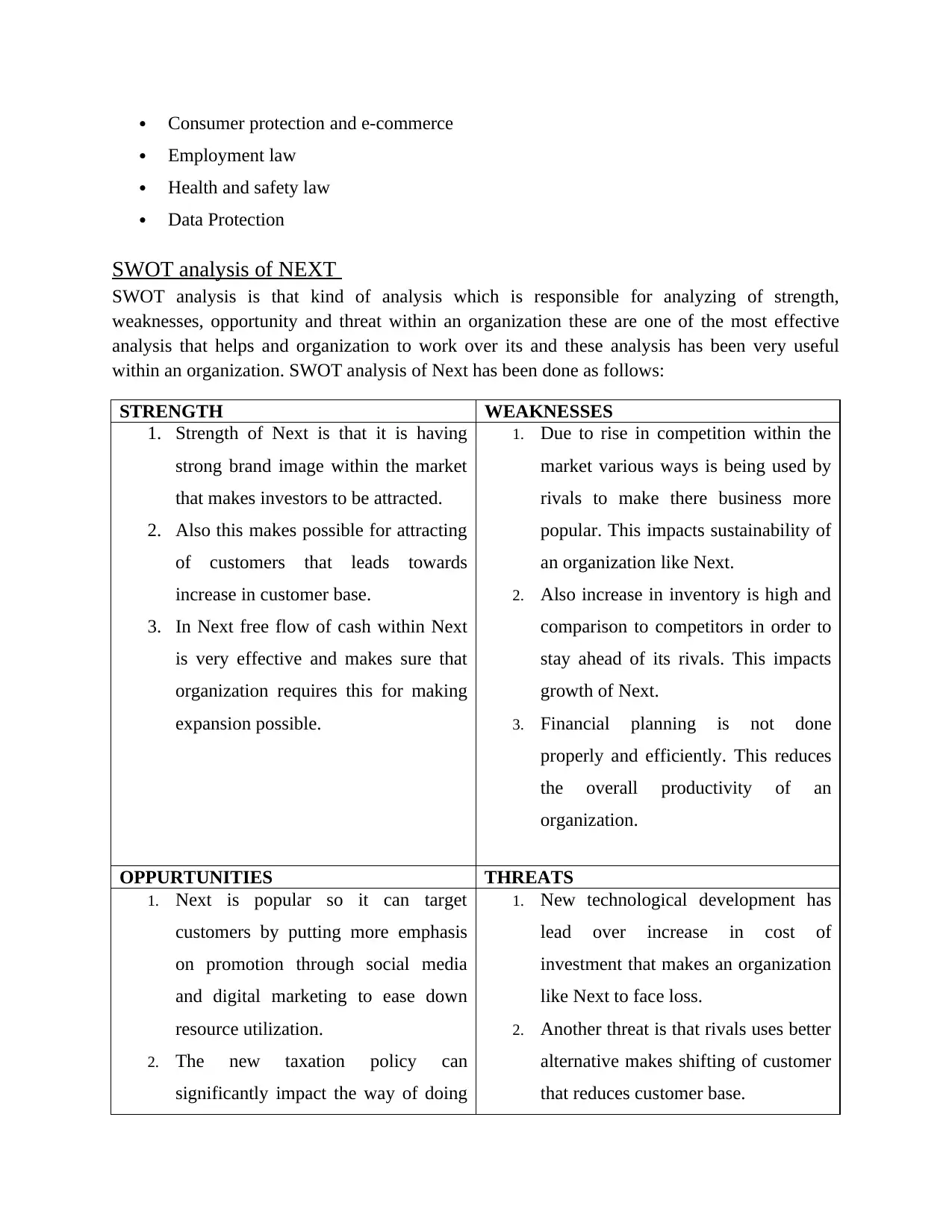
Consumer protection and e-commerce
Employment law
Health and safety law
Data Protection
SWOT analysis of NEXT
SWOT analysis is that kind of analysis which is responsible for analyzing of strength,
weaknesses, opportunity and threat within an organization these are one of the most effective
analysis that helps and organization to work over its and these analysis has been very useful
within an organization. SWOT analysis of Next has been done as follows:
STRENGTH WEAKNESSES
1. Strength of Next is that it is having
strong brand image within the market
that makes investors to be attracted.
2. Also this makes possible for attracting
of customers that leads towards
increase in customer base.
3. In Next free flow of cash within Next
is very effective and makes sure that
organization requires this for making
expansion possible.
1. Due to rise in competition within the
market various ways is being used by
rivals to make there business more
popular. This impacts sustainability of
an organization like Next.
2. Also increase in inventory is high and
comparison to competitors in order to
stay ahead of its rivals. This impacts
growth of Next.
3. Financial planning is not done
properly and efficiently. This reduces
the overall productivity of an
organization.
OPPURTUNITIES THREATS
1. Next is popular so it can target
customers by putting more emphasis
on promotion through social media
and digital marketing to ease down
resource utilization.
2. The new taxation policy can
significantly impact the way of doing
1. New technological development has
lead over increase in cost of
investment that makes an organization
like Next to face loss.
2. Another threat is that rivals uses better
alternative makes shifting of customer
that reduces customer base.
Employment law
Health and safety law
Data Protection
SWOT analysis of NEXT
SWOT analysis is that kind of analysis which is responsible for analyzing of strength,
weaknesses, opportunity and threat within an organization these are one of the most effective
analysis that helps and organization to work over its and these analysis has been very useful
within an organization. SWOT analysis of Next has been done as follows:
STRENGTH WEAKNESSES
1. Strength of Next is that it is having
strong brand image within the market
that makes investors to be attracted.
2. Also this makes possible for attracting
of customers that leads towards
increase in customer base.
3. In Next free flow of cash within Next
is very effective and makes sure that
organization requires this for making
expansion possible.
1. Due to rise in competition within the
market various ways is being used by
rivals to make there business more
popular. This impacts sustainability of
an organization like Next.
2. Also increase in inventory is high and
comparison to competitors in order to
stay ahead of its rivals. This impacts
growth of Next.
3. Financial planning is not done
properly and efficiently. This reduces
the overall productivity of an
organization.
OPPURTUNITIES THREATS
1. Next is popular so it can target
customers by putting more emphasis
on promotion through social media
and digital marketing to ease down
resource utilization.
2. The new taxation policy can
significantly impact the way of doing
1. New technological development has
lead over increase in cost of
investment that makes an organization
like Next to face loss.
2. Another threat is that rivals uses better
alternative makes shifting of customer
that reduces customer base.
Paraphrase This Document
Need a fresh take? Get an instant paraphrase of this document with our AI Paraphraser
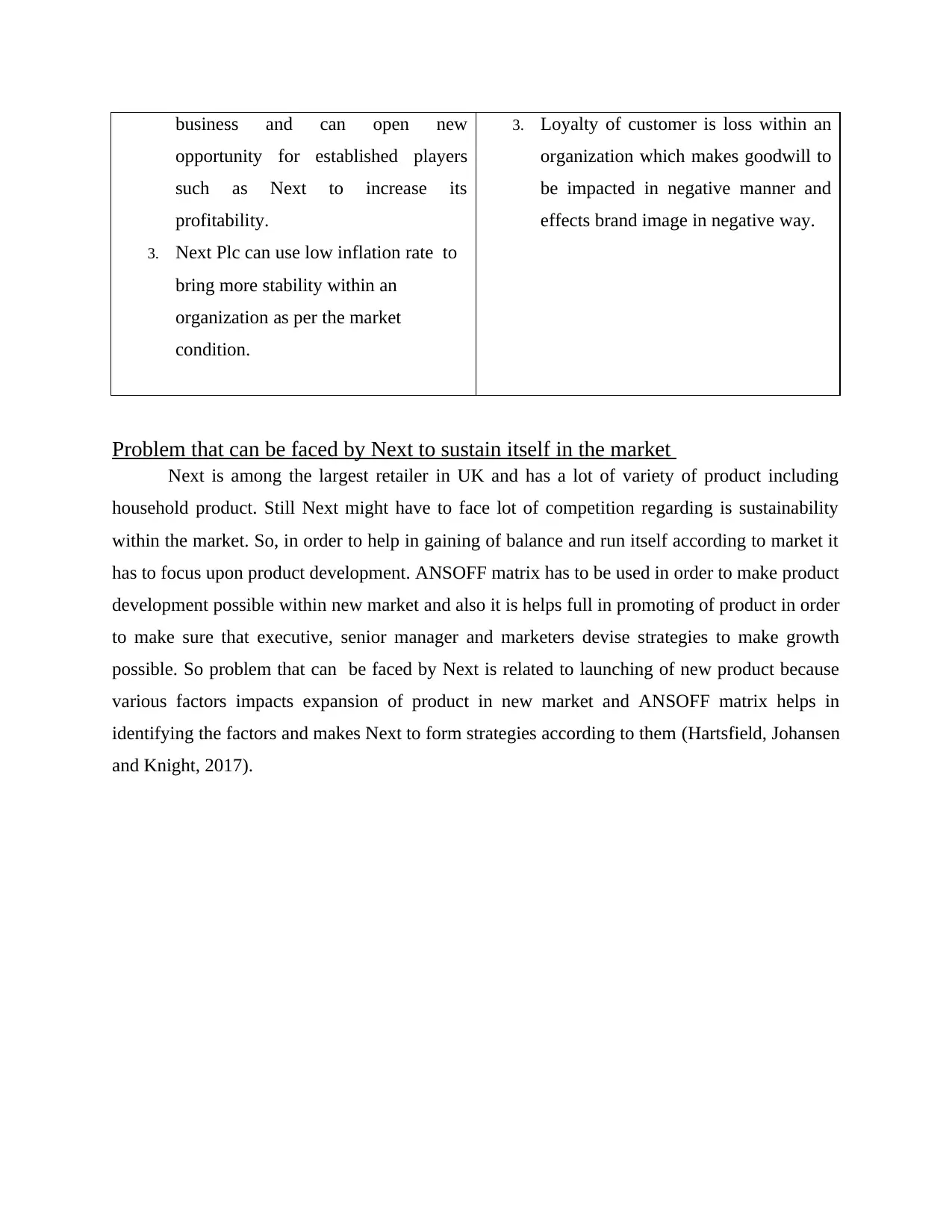
business and can open new
opportunity for established players
such as Next to increase its
profitability.
3. Next Plc can use low inflation rate to
bring more stability within an
organization as per the market
condition.
3. Loyalty of customer is loss within an
organization which makes goodwill to
be impacted in negative manner and
effects brand image in negative way.
Problem that can be faced by Next to sustain itself in the market
Next is among the largest retailer in UK and has a lot of variety of product including
household product. Still Next might have to face lot of competition regarding is sustainability
within the market. So, in order to help in gaining of balance and run itself according to market it
has to focus upon product development. ANSOFF matrix has to be used in order to make product
development possible within new market and also it is helps full in promoting of product in order
to make sure that executive, senior manager and marketers devise strategies to make growth
possible. So problem that can be faced by Next is related to launching of new product because
various factors impacts expansion of product in new market and ANSOFF matrix helps in
identifying the factors and makes Next to form strategies according to them (Hartsfield, Johansen
and Knight, 2017).
opportunity for established players
such as Next to increase its
profitability.
3. Next Plc can use low inflation rate to
bring more stability within an
organization as per the market
condition.
3. Loyalty of customer is loss within an
organization which makes goodwill to
be impacted in negative manner and
effects brand image in negative way.
Problem that can be faced by Next to sustain itself in the market
Next is among the largest retailer in UK and has a lot of variety of product including
household product. Still Next might have to face lot of competition regarding is sustainability
within the market. So, in order to help in gaining of balance and run itself according to market it
has to focus upon product development. ANSOFF matrix has to be used in order to make product
development possible within new market and also it is helps full in promoting of product in order
to make sure that executive, senior manager and marketers devise strategies to make growth
possible. So problem that can be faced by Next is related to launching of new product because
various factors impacts expansion of product in new market and ANSOFF matrix helps in
identifying the factors and makes Next to form strategies according to them (Hartsfield, Johansen
and Knight, 2017).
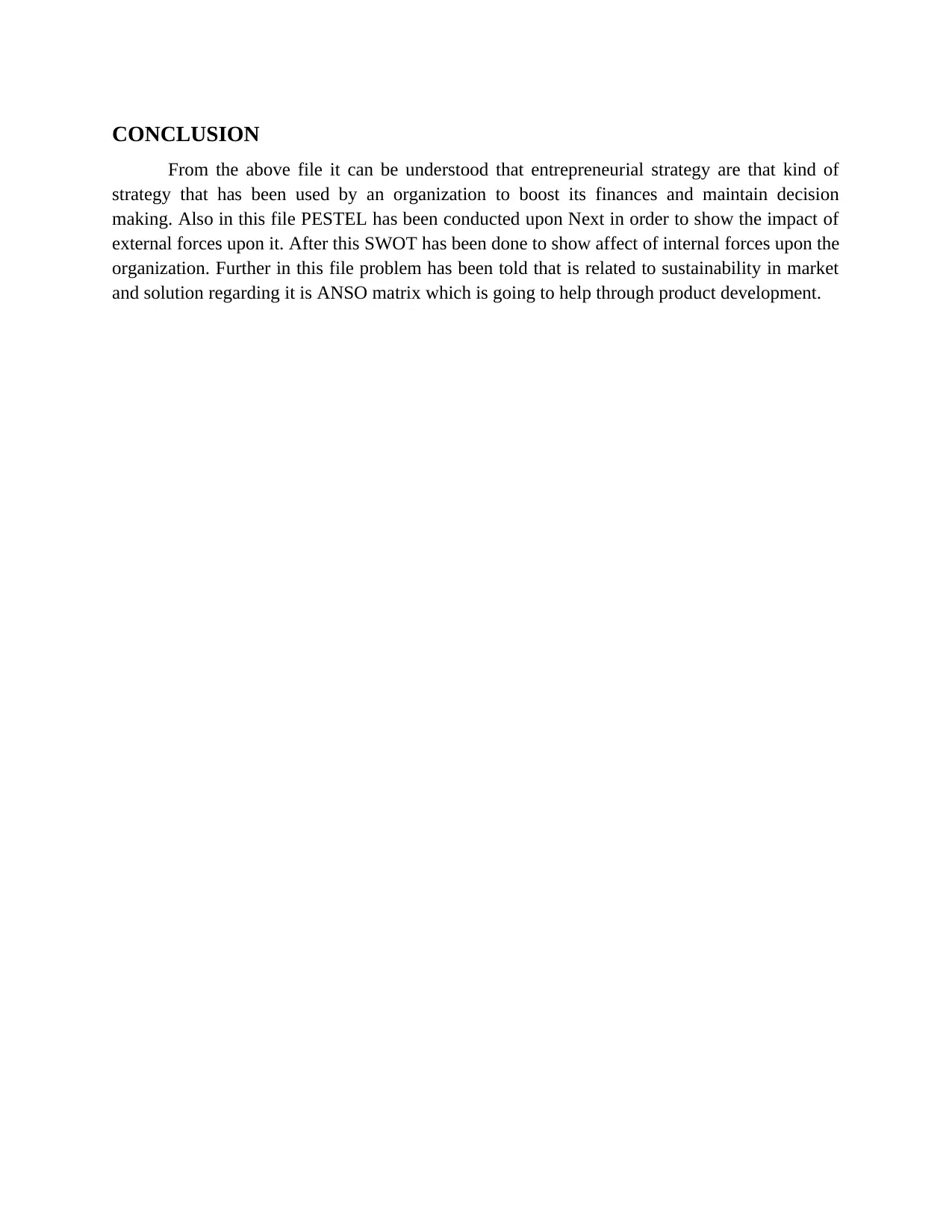
CONCLUSION
From the above file it can be understood that entrepreneurial strategy are that kind of
strategy that has been used by an organization to boost its finances and maintain decision
making. Also in this file PESTEL has been conducted upon Next in order to show the impact of
external forces upon it. After this SWOT has been done to show affect of internal forces upon the
organization. Further in this file problem has been told that is related to sustainability in market
and solution regarding it is ANSO matrix which is going to help through product development.
From the above file it can be understood that entrepreneurial strategy are that kind of
strategy that has been used by an organization to boost its finances and maintain decision
making. Also in this file PESTEL has been conducted upon Next in order to show the impact of
external forces upon it. After this SWOT has been done to show affect of internal forces upon the
organization. Further in this file problem has been told that is related to sustainability in market
and solution regarding it is ANSO matrix which is going to help through product development.
⊘ This is a preview!⊘
Do you want full access?
Subscribe today to unlock all pages.

Trusted by 1+ million students worldwide
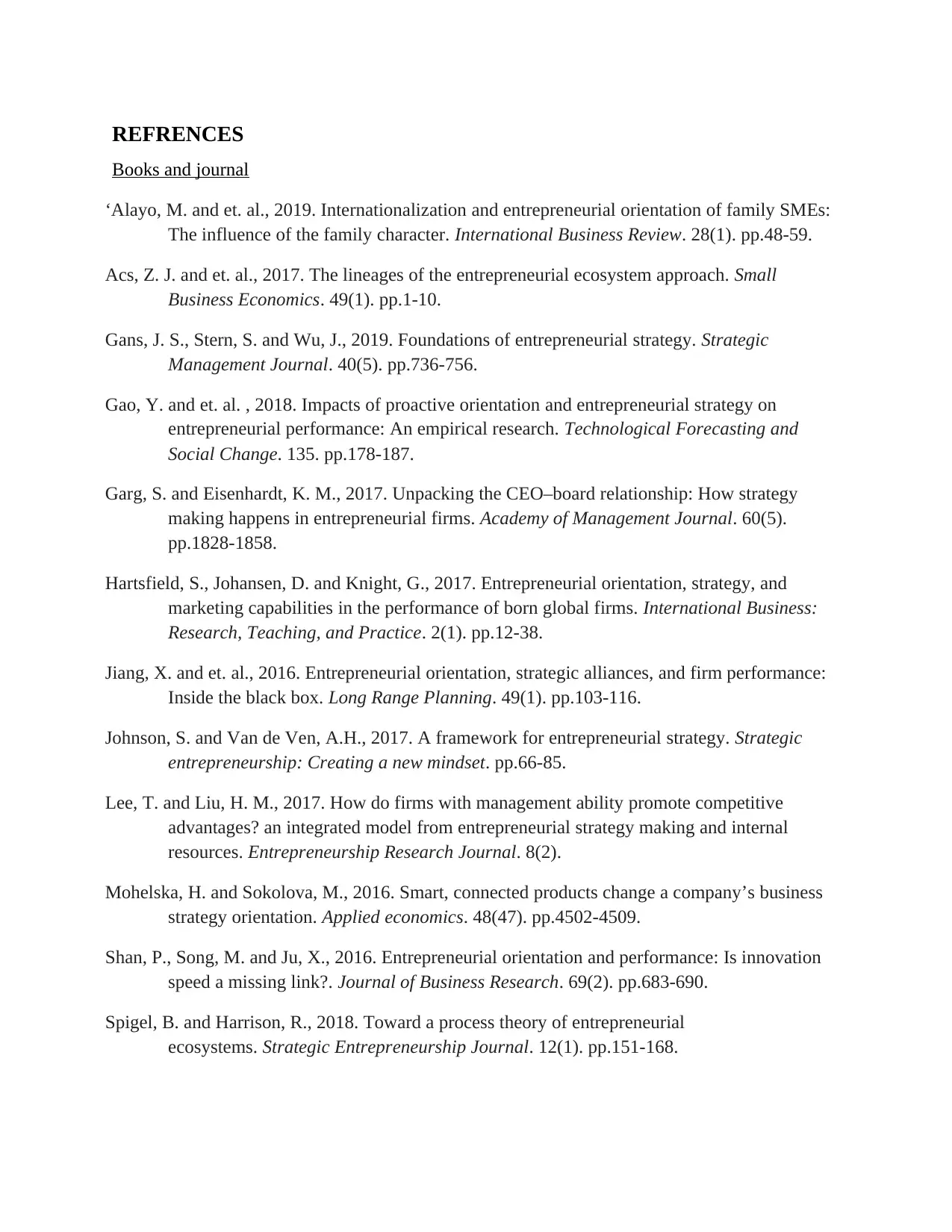
REFRENCES
Books and journal
‘Alayo, M. and et. al., 2019. Internationalization and entrepreneurial orientation of family SMEs:
The influence of the family character. International Business Review. 28(1). pp.48-59.
Acs, Z. J. and et. al., 2017. The lineages of the entrepreneurial ecosystem approach. Small
Business Economics. 49(1). pp.1-10.
Gans, J. S., Stern, S. and Wu, J., 2019. Foundations of entrepreneurial strategy. Strategic
Management Journal. 40(5). pp.736-756.
Gao, Y. and et. al. , 2018. Impacts of proactive orientation and entrepreneurial strategy on
entrepreneurial performance: An empirical research. Technological Forecasting and
Social Change. 135. pp.178-187.
Garg, S. and Eisenhardt, K. M., 2017. Unpacking the CEO–board relationship: How strategy
making happens in entrepreneurial firms. Academy of Management Journal. 60(5).
pp.1828-1858.
Hartsfield, S., Johansen, D. and Knight, G., 2017. Entrepreneurial orientation, strategy, and
marketing capabilities in the performance of born global firms. International Business:
Research, Teaching, and Practice. 2(1). pp.12-38.
Jiang, X. and et. al., 2016. Entrepreneurial orientation, strategic alliances, and firm performance:
Inside the black box. Long Range Planning. 49(1). pp.103-116.
Johnson, S. and Van de Ven, A.H., 2017. A framework for entrepreneurial strategy. Strategic
entrepreneurship: Creating a new mindset. pp.66-85.
Lee, T. and Liu, H. M., 2017. How do firms with management ability promote competitive
advantages? an integrated model from entrepreneurial strategy making and internal
resources. Entrepreneurship Research Journal. 8(2).
Mohelska, H. and Sokolova, M., 2016. Smart, connected products change a company’s business
strategy orientation. Applied economics. 48(47). pp.4502-4509.
Shan, P., Song, M. and Ju, X., 2016. Entrepreneurial orientation and performance: Is innovation
speed a missing link?. Journal of Business Research. 69(2). pp.683-690.
Spigel, B. and Harrison, R., 2018. Toward a process theory of entrepreneurial
ecosystems. Strategic Entrepreneurship Journal. 12(1). pp.151-168.
Books and journal
‘Alayo, M. and et. al., 2019. Internationalization and entrepreneurial orientation of family SMEs:
The influence of the family character. International Business Review. 28(1). pp.48-59.
Acs, Z. J. and et. al., 2017. The lineages of the entrepreneurial ecosystem approach. Small
Business Economics. 49(1). pp.1-10.
Gans, J. S., Stern, S. and Wu, J., 2019. Foundations of entrepreneurial strategy. Strategic
Management Journal. 40(5). pp.736-756.
Gao, Y. and et. al. , 2018. Impacts of proactive orientation and entrepreneurial strategy on
entrepreneurial performance: An empirical research. Technological Forecasting and
Social Change. 135. pp.178-187.
Garg, S. and Eisenhardt, K. M., 2017. Unpacking the CEO–board relationship: How strategy
making happens in entrepreneurial firms. Academy of Management Journal. 60(5).
pp.1828-1858.
Hartsfield, S., Johansen, D. and Knight, G., 2017. Entrepreneurial orientation, strategy, and
marketing capabilities in the performance of born global firms. International Business:
Research, Teaching, and Practice. 2(1). pp.12-38.
Jiang, X. and et. al., 2016. Entrepreneurial orientation, strategic alliances, and firm performance:
Inside the black box. Long Range Planning. 49(1). pp.103-116.
Johnson, S. and Van de Ven, A.H., 2017. A framework for entrepreneurial strategy. Strategic
entrepreneurship: Creating a new mindset. pp.66-85.
Lee, T. and Liu, H. M., 2017. How do firms with management ability promote competitive
advantages? an integrated model from entrepreneurial strategy making and internal
resources. Entrepreneurship Research Journal. 8(2).
Mohelska, H. and Sokolova, M., 2016. Smart, connected products change a company’s business
strategy orientation. Applied economics. 48(47). pp.4502-4509.
Shan, P., Song, M. and Ju, X., 2016. Entrepreneurial orientation and performance: Is innovation
speed a missing link?. Journal of Business Research. 69(2). pp.683-690.
Spigel, B. and Harrison, R., 2018. Toward a process theory of entrepreneurial
ecosystems. Strategic Entrepreneurship Journal. 12(1). pp.151-168.
Paraphrase This Document
Need a fresh take? Get an instant paraphrase of this document with our AI Paraphraser

1 out of 11
Related Documents
Your All-in-One AI-Powered Toolkit for Academic Success.
+13062052269
info@desklib.com
Available 24*7 on WhatsApp / Email
![[object Object]](/_next/static/media/star-bottom.7253800d.svg)
Unlock your academic potential
Copyright © 2020–2025 A2Z Services. All Rights Reserved. Developed and managed by ZUCOL.




